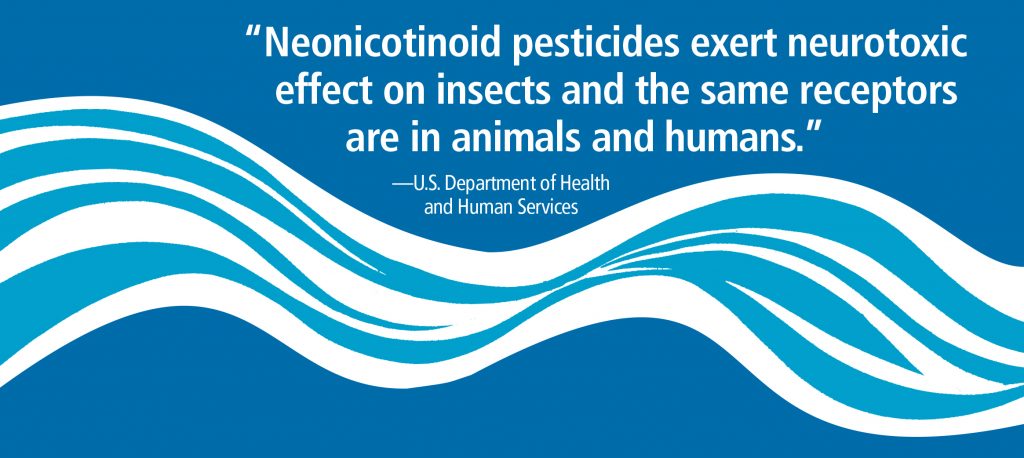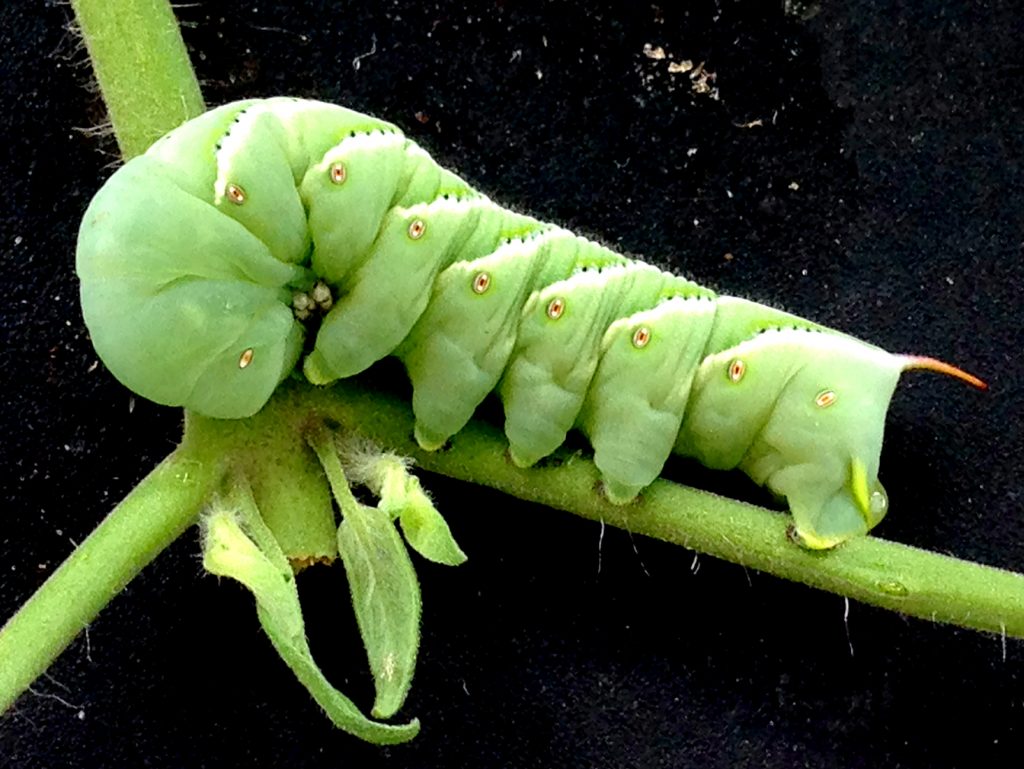
Pesticide is an overarching term meaning a compound which kills fungus, bacteria, insects, or weeds. Insecticides target insects while herbicides target weeds. In this article, we address two pesticides, glyphosate and neonicotinoids, that have widespread deleterious effects on humans and ecosystems. Manufacturing of these pesticides continues unabated, with profits soaring while plant, animal, and insect life are plummeting. At the end of this article, you’ll find recipes for natural pesticides you can make yourself.
Monsanto brought the herbicide glyphosate (found in Round Up and 750 other products) to market in 1974. In 2015, the World Health Organization commissioned a study of glyphosate. Scientists from eleven countries reviewed a growing body of literature and came to the conclusion that the herbicide was a probable carcinogen with a strong link to non-Hodgkin lymphoma. They also found evidence that it causes DNA and chromosome damage in humans. Now many countries in Europe have banned glyphosate use.
Glyphosate also may be implicated in the global drop in bee populations. Ninety percent of our food crops are pollinated by bees. Bee numbers have decreased in the U.S. by 60% and in Europe by 30%. One of the suspected causes is that glyphosate is toxic to enzymes found in the stomachs of bees. When the microbiome of the bee’s stomach is weakened, the bee becomes more susceptible to disease and premature death.
Pesticides with neonicotinoids were first marketed by Bayer in the 1990s; today, neonicotinoids are the most widely used class of insecticides world-wide. They are also having a devastating effect on bees and other beneficial insects. When sprayed on plants, neonicotinoids are absorbed by the plant and then contaminate the pollen and nectar. Harmful levels can remain in the environment for months. Neonicotinoids cause queen bees to be infertile and also causes difficulties in flight and brain function. The European Union banned the use of three neonicotinoids and are monitoring beehive numbers and health. In the U.S., Fish and Wildlife banned their use in Wildlife Refuges, but this ban was rolled back by the previous administration. During the 2021 New Mexico legislative session, Senator Mimi Stewart introduced a bill which would have provided some protections from exposure to neonicotinoids, but the bill did not pass.

Most insects have a beneficial role in nature, especially pollination, and most plants are beautiful or edible. We want both insects and plants; their survivals are intertwined with our needs. An example of the insect/plant relationship in our watershed is the tomato worm, the hawk moth, and the Sacred Datura plant. In one night, the big, green, juicy caterpillar can denude four or five branches of a tomato plant. This larvae stage metamorphosizes into pupae and then the hawk moth. With a nearly four-inch wingspan, this giant moth is the only pollinator for the Sacred Datura, also called Jimson or Loco Weed. The latter is used globally for medicines and purposefully cultivated in Germany, France, and parts of South America to treat various illnesses such as asthma, hallucinations, toothaches, and even dandruff. If you discover a tomato worm and there are white spikes coming out of its body, a parasitic wasp will have already laid its eggs, and soon the worm will be eaten by the wasp larvae. No need to do anything! In fact, the soon-to-hatch wasps will clear out the rest of your tomato worms. However, if the tomato worm doesn’t have white spikes, you might want to kill the caterpillar; after it finishes your tomatoes, it will move on to your eggplants and peppers.
INSECTICIDES
After you have identified which insect is causing a problem in your garden, you may try some of these treatments: (T. = Tablespoon, t. = teaspoon, oz. =ounce, qt. = quart)
* Oil Spray – 1 cup vegetable oil, 1 T. liquid soap . Shake well. Add 2 t. to 1 qt. water
Use on aphids, mites, thrips (sucking insects)
* Soap Spray – 1 ½ t. liquid soap, 1 qt. water. Use as spray only in cool part of day.
Good for aphids, mites, white flies, beetles, scale insects.
* Neem Oil (from seeds of the Neem tree) – 2 t. Neem Oil, 1 t. liquid soap, 1 qt. water.
Works for eggs, larvae, adult insects, and powdery mildew. Spray onto leaves.
* Vinegar – mix 1:1 with water. Wipe down counters and other kitchen surfaces
Good for sugar ants.
* Diatomaceous Earth (fossilized algae) – Sprinkle on foliage or ground. Re-do after rain.
Controls for ants, slugs, snails, and other crawling insects by drying them out.
* Garlic Spray (repellent) – Puree 2 bulbs garlic with 1 qt. water. Let stand overnight. Strain
Add ½ c. vegetable oil and 1 t. liquid soap.
Deters grasshoppers and Japanese beetles.
* Chile Pepper Spray (repellent) – 1 T. chili powder, 1 qt. water, 3 drops liquid soap
Use full strength on leaves.
* Shredded tobacco leaves. Has been found to be useful around the trunks or plum,
peach, cherry trees to deter pit bores
HERBICIDES
* Boiling water – good for sidewalk cracks but must be repeated multiple times.
* Heat – flame equipment is good for sidewalk cracks.
* Salt water – 1 part salt to 8 parts water, 1 t. liquid detergent. Spray onto leaves so will
not soak into soil. Repeat as needed over summer.
* Vinegar – 1 c. with 1 t. liquid soap. Spray onto leaves. Repeat as needed over summer.
* Barrier covering – good for controlling grasses. Layers of newspaper or cardboard can be placed and then covered with mulch for several growing seasons. The paper/cardboard will ultimately deteriorate. Black plastic is often used, but because no moisture can penetrate this will also kill beneficial soil fungus and bacteria. A weed barrier may be used, but for water to get through, it must be heavily moistened. Since trees have a root area even spreading beyond their drip line, poorly placed landscape fabric can cut off the small tree root ends’ ability to absorb water. Treehugger.com has more good information.
Other tips: Don’t plant all the same kind of plants in the same area. If a predatory insect comes to attack your plant, there won’t be others nearby to attack.
Plants such as chrysanthemums, mint, and marigolds can be planted near vegetables to deter certain insects.
You may keep pesticides from being sprayed by the city on your property/curb by calling 311 and asking to be connected to the “No Spray List”
Dispose of hazardous pesticides by going to Household Hazardous Waste (ACT) at 6137 Edith NW M-W-F 8:30 – 4:30 Sat. 8 – 3


Hi. There is an organization that fights against the use of glyphosate in public areas. Check-out Non Toxic Communities (http://www.nontoxiccommunities.com/). They have had some remarkable victories in school districts, in cities large and small, and in counties. Do you know if Albuquerque or other Rio Grande cities have banned the use of glyphosate in public areas?
No they haven’t, Esther. Bernalillo County is the only one so far. As the person who spear headed the Burque Bee City designation, I can report on what we are doing:
We just completed a pesticide in-service with the departments of CABQ, which oversee all public spaces.
Parks and Rec
Solid Waste
Environmental Health.
All are doing things below the radar to cut/reduce usage. Parks and Rec has cut their use of glyphosate almost in half. Solid Waste, I’m not so sure. I need to follow up on them. They couldn’t didn’t offer to report anything about their pesticide use when we opened up the meeting to Q&A.
Enviro Health has an amazing team committed to biology and they are also really remediating their programs to be pollinator friendly.
All this to say, that the city is working on reducing glyphosate per Burque Bee City. The biggest problem sprayer for public space would be the Middle Rio Grande Conservancy District since they oversee ditches and along the Bosque. They do not answer to Burque Bee City, though, as a regional agency. I’ve met with Mike Haman and Yasmeen, their main biologist multiple times. They are receptive, but changing the spray culture isn’t easy. Clearly the City says, we need to address consumer practices. Some of the biggest culprits are backyard sprayers. The big box stores are loaded with glyphosate.
Think Like a Bee has done public announcements, radio and t.v. spots for years asking the public not to spray and consider alternatives. So, you could begin with your neighborhood association, educating them about Burque Bee City, pollinators and pesticides. You could invite the neighborhood assoc. to work with parks and rec and solid waste, requesting them not to spray. P&R are willing to not spray if the neighborhood says “we will pull weeds mechanically/by hand and take care of our own zone”. They are already doing this with some neighborhoods.
Hope this helps. Here’s a few websites: https://www.cabq.gov/parksandrecreation/open-space/bee-city-usa
https://thinklikeabee.org